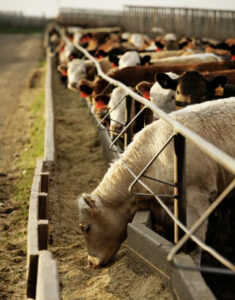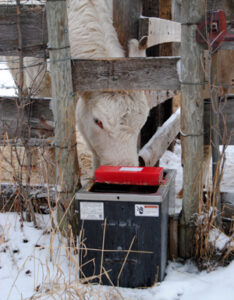How Much Feed and Water are Used to Make a Pound of Beef?
[Update] A new study has found that Canada’s beef industry has dramatically reduced its water footprint over the past several decades, and that trend is expected to continue. Learn more at The Canadian Beef Water Footprint in Shrinking, published December 14, 2017
We recently received an email asking: “I’ve read that it takes 16 lbs of plant material and 5000 gallons of water to make a pound of beef. How far from the truth is this?“
So we calculated just how much feed and water beef cattle do use before they’re harvested.
Feed 
In terms of plant material, because water content is higher in some feeds than in others, feed use is measured on a dry matter basis. Feed conversion (pounds of feed consumed per pound of live animal gain) varies with the type of feed an animal is fed, how it is processed, etc. Current feed to gain ratios in a feedlot animal are about 6lbs of feed per 1lb of live weight gain.
For example, if an animal enters the feedlot at 500lbs and finishes at 1400lbs live weight (which will produce an 868lb carcass with 512lb of edible beef), that animal needs to gain 900lbs. At a 6:1 conversion, that’s 5400lbs of total feed used.
5400lbs feed ÷ 512lbs beef =
10.6 lbs feed per pound of edible beef.
In western Canada, much of the feed used for feedlot cattle is either barley that didn’t make the grade for brewing, or sometimes wheat that didn’t make the grade for bread milling, or grain that spoiled in storage. For instance, you hear a lot about the rail shipping backlog leaving lots of grain on the farm. Given last year’s bumper crop, a lot of that grain was stored on the ground and spoiled. Spoiled grain is no longer good for beer or bread, but it’s fine for cattle. Feeding it to cattle means that grain doesn’t go to waste.
Back in the 1950’s, feed conversion ratios were nearly 11:1, meaning that it took nearly twice as much feed to produce a pound of beef. Genetic selection and innovations continue to improve feed conversion in cattle.
Water
Based on average daily consumption numbers available here, a beef animal that reaches slaughter weight at 21 months would probably drink about 18,600 liters (4,091 gallons) of water. That animal produces around 512 lbs of edible beef.

4,091 gallons ÷ 512lb beef =
8 gallons of water per pound of edible beef.*
Many cattle go to slaughter at earlier ages, in which case that water use number would be lower.
Cows use water, but they don’t use it up. Water cycles. Only a very small fraction of the water consumed is retained in the body. Most of the water that cattle drink continues to cycle in the environment.
*Note that water used during processing was not included, nor water used for irrigation to grow feed (some parts of the country use irrigation, some don’t), because accurate data is currently unavailable. However, we do know that both irrigation systems and packing plants have become much more efficient in water use.
Progress
It is safe to say that as an industry, we’re doing a lot better at using water than we used to. Back in the 1950’s, cattle were closer to 3 years of age at slaughter, would have drank closer to 50,000 liters (11,000 gallons), and produced a much smaller carcass (250 lb edible beef). It would have taken 44 gallons per pound of edible beef, instead of the 8 gallons per pound today. (That’s still a far cry from 5,000 gallons per pound!)
Canada’s beef industry produces more beef now, using a lot less water and feed than we used to. That’s good for farm economics, and helps keep beef affordable for consumers. At the same time, improvements in feed efficiency also mean that we’re producing less greenhouse gas and manure per pound of beef. That’s good for the environment.
[Update] A new study has found that Canada’s beef industry has dramatically reduced its water footprint over the past several decades, and that trend is expected to continue. Learn more at The Canadian Beef Water Footprint in Shrinking, published December 14, 2017
Learn More
- Questioning the beef industry’s water use
- Optimizing Feedlot Feed Efficiency
- Environmental Footprint of Beef Production
Click here to subscribe to the BCRC Blog and receive email notifications when new content is posted.
The sharing or reprinting of this BCRC Blog article is welcome and encouraged. Please provide acknowledgement to the Beef Cattle Research Council, list the website address, www.BeefResearch.ca, and let us know you chose to share the article by emailing us at info@beefresearch.ca.
We welcome your questions, comments and suggestions. Contact us directly or generate public discussion by posting your thoughts below.

